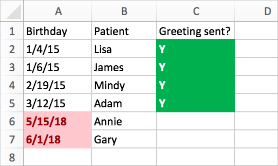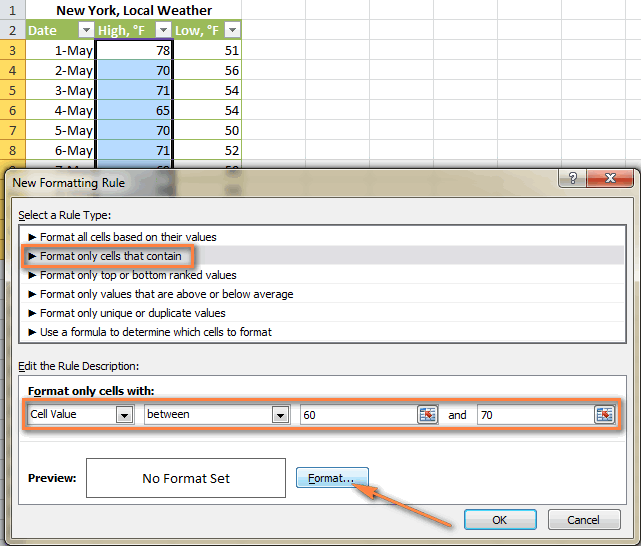
By using your own formula, you take over the condition that triggers a rule and can apply exactly the logic you need. However, you can also create rules with your own custom formulas. With conditional formatting, you can do things like highlight dates in the next 30 days, flag data entry problems, highlight rows that contain top customers, show duplicates, and more.Įxcel ships with a large number of "presets" that make it easy to create new rules without formulas. If you are used to creating complex formulas that cover all cases in one cell, it may take a little re-learning to figure out the approach for conditional formatting that works more incrementally.Quick Start | Examples | Troubleshooting | TrainingĬonditional formatting is a fantastic way to quickly visualize data in a spreadsheet. In this example, we applied the rule to the Client cells and the formula would be:

If you don’t have, or don’t want to create, a helper column with an IF/THEN statement, you can use the same method as the first scenario by creating a rule that determines whether a client is over budget. Solution 2: Create a formula to calculate retainer budget. Highlight the cell range, Click on Conditional Formatting > Highlight Cell Rules > Text that Contains to create the Rule, then type YES in the Text that Containsdialog box. Our Conditional Formatting rule, then only has to look for the text string “YES” and apply the formatting when true. In this example, we already have an IF/THEN formula that returns the result “YES” if our client is over their retainer budget. You don’t necessarily need to reproduce the logic in the rule itself. If your worksheet already has the IF/THEN/ELSE logic you need embedded in a cell, Conditional Formatting can act based on those results. Solution 1: Create a helper column using IF/THEN formula to call out whether a client is over their retainer budget. You want to highlight the clients who are over their retainer. Scenario 2 (Retainers tab): You have a table of how many hours your employees have worked for specific clients, and you have a table of how many hours each client has in their retainer budget.
:max_bytes(150000):strip_icc()/ExcelConditionalFormattingNewRule-5c57373f4cedfd0001efe4d4.jpg)
See Get the Most Out of Excel’s Conditional Formatting for more ideas. By changing the Applies to range, however, you can easily highlight a different cell – such as the birthdate – or the entire row. Then, create a second rule for the same range using this formula to highlight birthdays that are not in your department:īONUS! In this example, we applied the rule to the department cell to show the relationship to the formula. If you are reproducing the exercise in a different month, you will see different results! This example was created in April, so April birthdays will be highlighted. To create a formula that generates a TRUE/FALSE statement that highlights birthdays only in one department, you would use the formula: The formula to identify birthdays in the current month will be ( see this article for more about using dates in conditional formatting): Step 1 – Highlight birthdays in your department Solution: Create two rules – one for your department, one for all others Scenario 1 (Birthdays tab): You want to highlight all employees in your department who have a birthday this month with Red, and all other departments blue.
#Find color value of conditional formatting excel 2016 download#
To follow using our examples, download 04-If-Then Conditional Formatting. Let’s look at a few scenarios to get a sense of how we can create the effect of IF/THEN conditional formatting, even if we can’t use it in the feature itself: Instead, this would require TWO rules, one for “greater than 10” and one for “less than 10”.

What conditional formatting can’t do in a single rule is an IF/THEN/ELSE condition such as “If # is greater than 10 format red, else format green”. Any conditional formatting argument must generate a TRUE result, meaning that at a literal level, your conditional formatting rule is an If/Then statement along the lines of “If this condition is TRUE, THEN format the cell this way”. A question that often comes up among these “conditional formatting addicts” is Can I use If/Then formula to format a cell? If you are a fan of Excel’s conditional formatting feature, you probably find looking for even more and more ways to highlight useful information in your data. *Steps in this article will apply to Excel 2007-2016. By Tepring Crocker Categories: Conditional Formatting, Excel® Tags: If/Then Conditional formatting


 0 kommentar(er)
0 kommentar(er)
